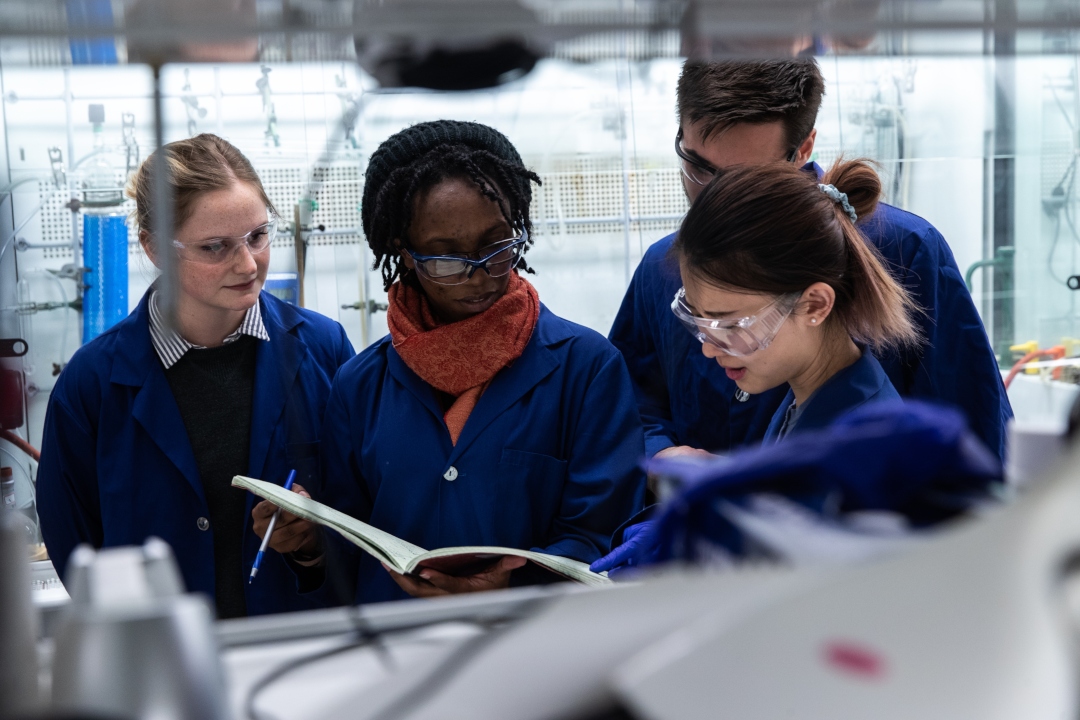From filling consumer orders for shampoos and cosmetics to making life-saving drugs to meeting industrial demands for glues and solvents, chemists are skilled at designing molecules to meet societal needs. But, according to Assistant Professor of Chemistry Adelina Voutchkova-Kostal, chemists who make commodity chemicals are typically not trained to consider the unintended long-term effects of their work on humans, animals and the environment. “That task has traditionally been left to toxicologists further down the production line,” she said.
Now Voutchkova-Kostal is trying to change the way science does business—both in her research and her academic work. In Columbian College’s Environmental and Green Chemistry Program, she is helping students learn how to design safer chemicals through environmentally-friendly methods. “The rules of green chemistry are common sense,” she said. “Don’t make things that harm people and the environment and make them in ways that aren’t harmful either.”
Beyond her work with students, Voutchkova-Kostal—a past winner of the prestigious National Science Foundation (NSF) CAREER award—is collaborating with Assistant Professor of Chemistry Jakub Kostal on a $300,000 NSF research project to devise an environmentally-safe process for converting wood into chemicals. The goal is to make non-toxic solvents that essentially dissolve trees, turning them into a solution that can be used to manufacture chemicals. In the course of the project, “we are applying the principles of green chemistry across the board,” she said. “We have a problem and we have to find a green solution and a green path to get there.”
The Chemical World
There’s no escaping chemicals in our daily lives. Commercial cleaners, sunscreens, paints, varnishes—“everything you touch is a chemical formulation of some sort,” Voutchkova-Kostal said. More than 65,000 chemicals are currently in the marketplace with 700 new ones appearing each year. Still, there is scant health and safety data for about 80 percent of the chemicals in commercial use, according to Voutchkova-Kostal.
In the United States, the burden of determining whether new chemicals brought to market pose a health or safety risk falls on the Environmental Protection Agency (EPA) rather than industry manufacturers. (In the European Union, for example, companies are required to provide health and safety data for new chemicals.)
Meanwhile, laboratory scientists are making new chemicals that are introduced into the market, often without knowing how the chemical might be used in the future. For example, Voutchkova-Kostal notes, the controversial chemical BPA was originally designed as a synthetic hormone. In the 1960s, it was repurposed as an additive to plastics including consumer goods like food and beverage containers.
In contrast, green chemistry promotes minimizing the risk that a new chemical will have adverse biological effects before it’s ever synthesized. Rather than measuring their harmful effects after they’ve been released into the environment, “we can design safer molecules from the start,” she said.
That’s a key component to Columbian College’s green chemistry program. The interdisciplinary curriculum was created with input from the EPA, the Food and Drug Administration, national research labs and chemical companies including Dowd and DuPont. It combines traditional courses like organic and computational chemistry with instruction in chemical toxicology, giving students a big-picture perspective of how their work impacts the world outside the lab.
“There’s an emphasis on real-world applicability rather than a sole focus on academic exercises,” said Savannah Sierco, a second-year master’s student in environmental and green chemistry. “That’s what is most rewarding to me. You can see where your work could be used to benefit health and safety.”
Wood-Stock
For the NSF project, Voutchkova-Kostal is attempting to move the chemical industry away from its heavy reliance on oil. Most chemicals are petroleum-based; about 20 percent of the world’s oil-resources are used to make chemicals. But, as Voutchkova-Kostal notes, “we have to find new environmentally sustainable ways of making chemicals.” Food crops like corn are a potential alternative but, with food scarcities around the world, they’re in short supply as well. “We don’t want to touch them,” she said.
The best remaining option, scientists agree, is wood biomass—essentially turning trees into the raw material for chemicals. “Using wood instead of crops. . . to make chemicals ensures that chemical manufacture does not compete with our food production,” Voutchkova-Kostal said. But converting wood into chemical material offers practical challenges—specifically, she explains, “How do you get the tree into a pot? How do you dissolve it?”
The good news, according to Voutchkova-Kostal, is that molten salt solvents have proven effective in melting wood biomass. The bad news is they are also highly toxic. Among Voutchkova-Kostal’s research challenges will be manipulating the molecular structure of the solvent to maintain its effectiveness while reducing its toxic properties. “You modify these molecular building blocks and hope you hit on a formula that satisfies everyone,” she said. Along the way, the project will follow the same green chemistry guidelines at Voutchkova-Kostal teaches her students in the classroom, creating safer chemicals through safer processes.
“Green chemistry empowers students to seek solutions to the challenging problems of minimizing our impact on the planet,” she noted. “Eventually all chemistry will be green. We are a long ways from being there. But our students will be the ones leading the way.”


